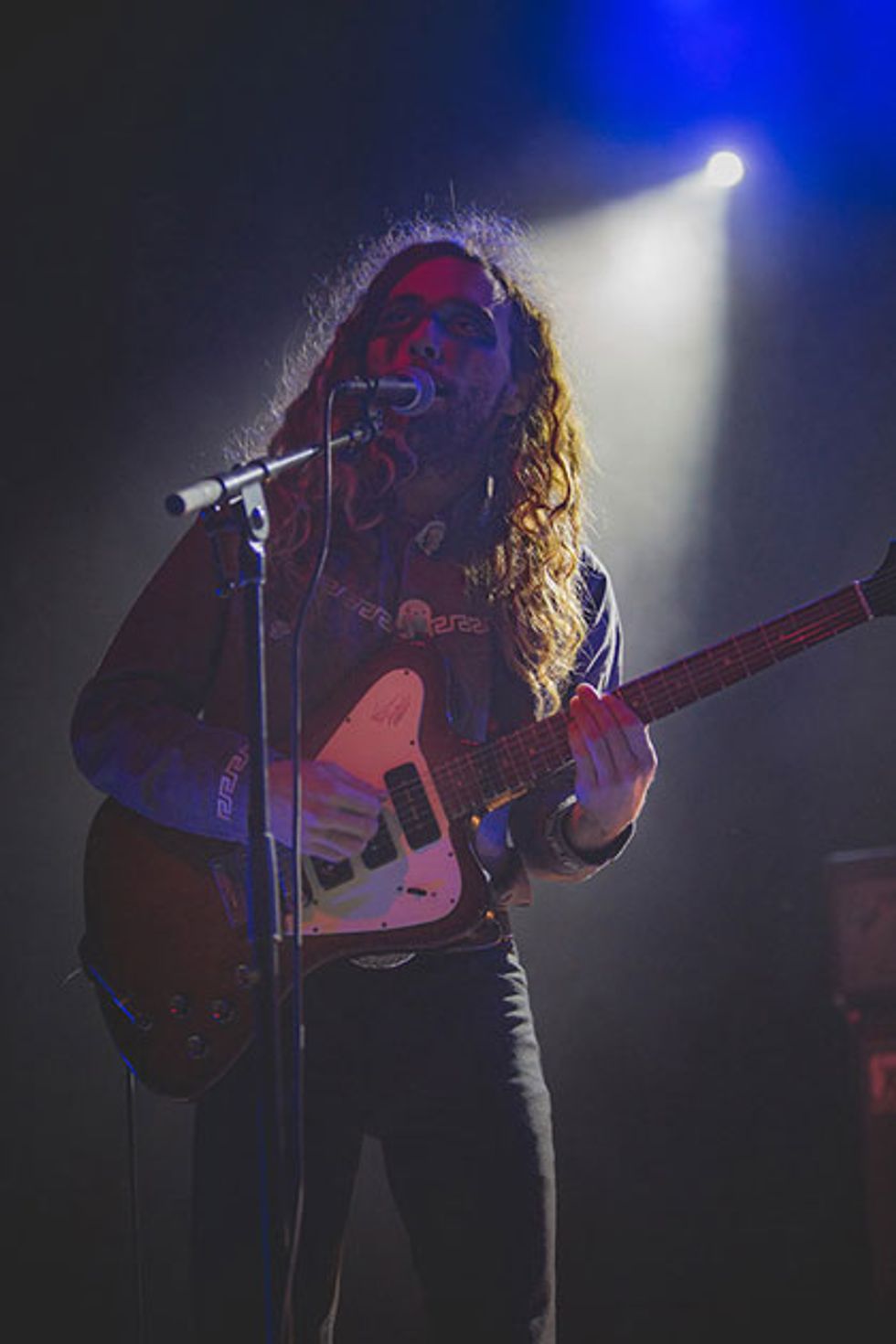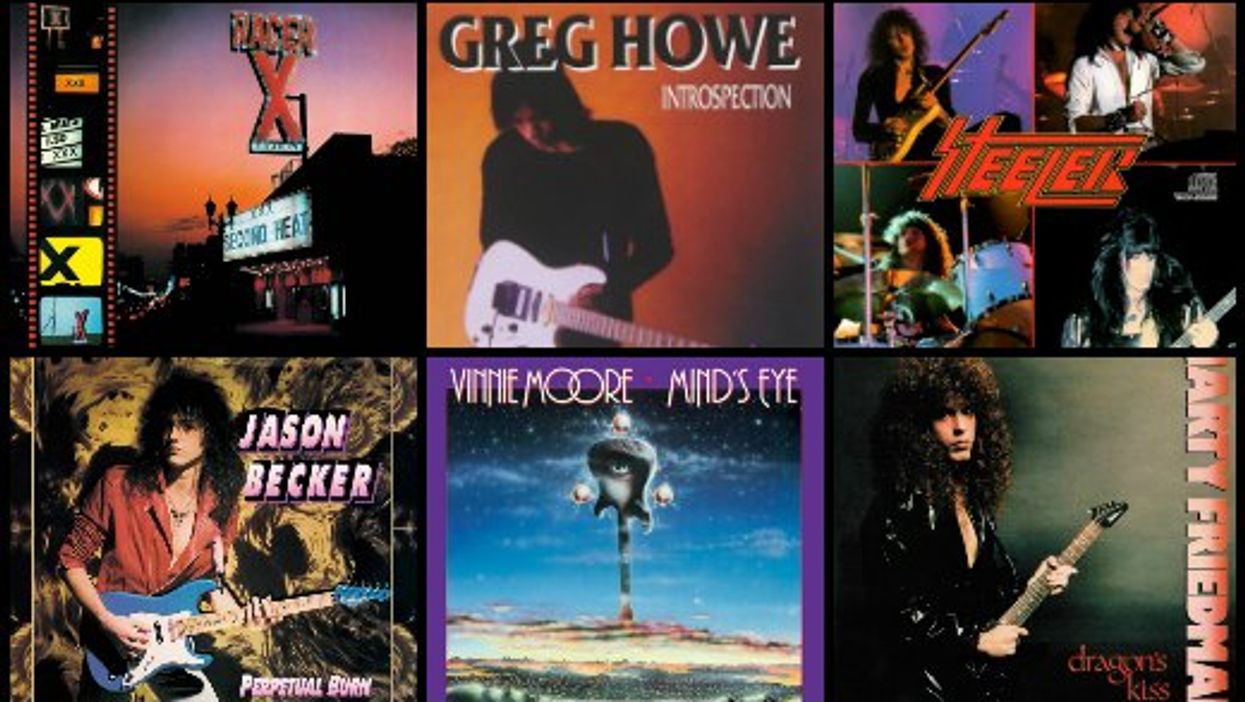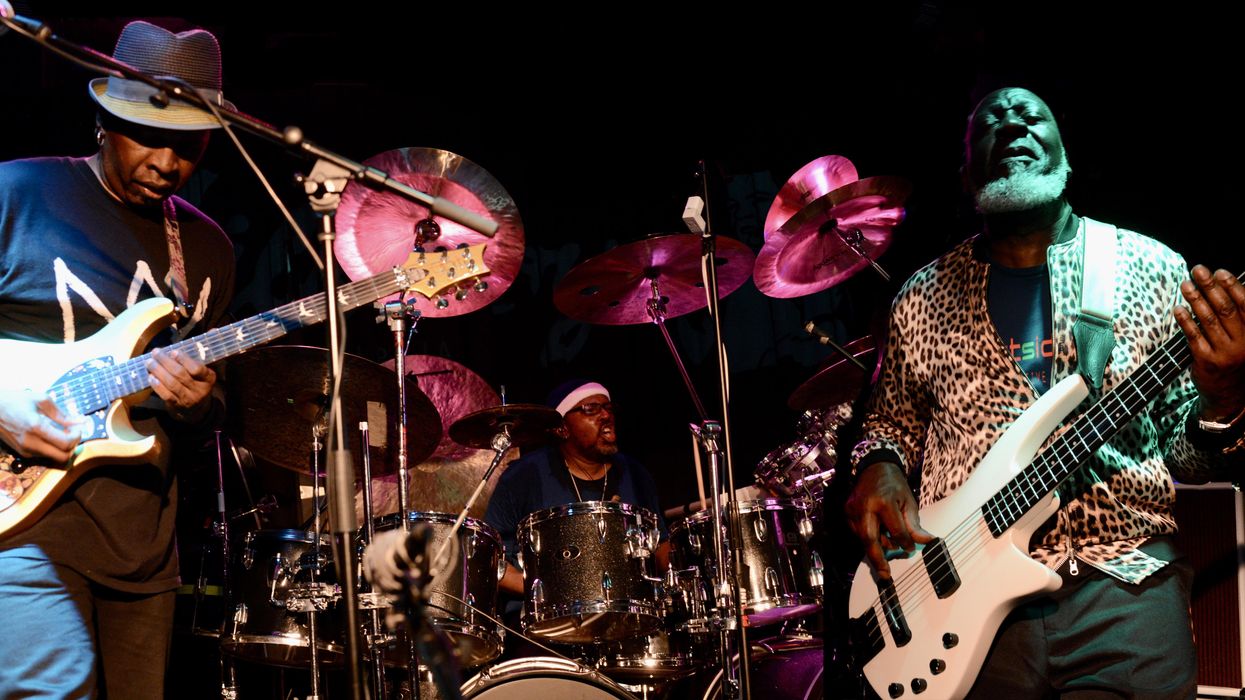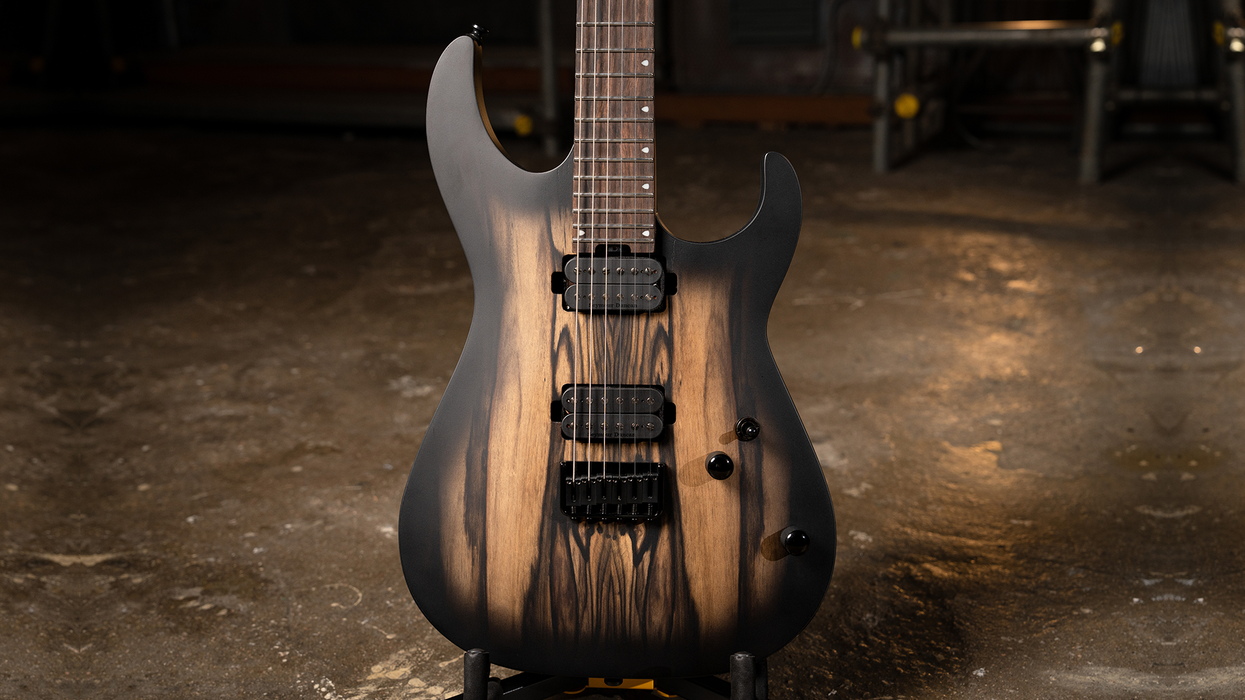Want loud? Los Angeles-based power trio Fuzz does that, pounding out relentless, ear-splitting riffs with abandon. But they do more, too. For starters, Fuzz is a guitar band par excellence. Name another band where every member—even the drummer—is a guitar-playing badass. Team Fuzz dominates the new wave of SoCal garage-punk-psychedelic-stoner-rock. They are prolific, restless, enigmatic, ubiquitous—their combined output is prodigious—and they’re forever releasing, touring, or supporting something.
At their core, Fuzz is simple enough. Ty Segall (singer, songwriter, guitarist, and solo artist) sings and plays drums. Chad Ubovich (guitar and vocals with the Meatbodies, guitar and bass with Mikal Cronin) holds down the low end. And Charles Moothart (guitar with Ty Segall, GØGGS, and more) plays guitar and is the band’s primary riff generator. With so many different projects, maintaining focus could be difficult. Moothart says it isn’t. “Fuzz is a very specific sound so it’s an easy thing to separate in that way,” he says. “We know what the vibe is going to be and we know what we’re trying to do.”
YouTube It
Watch Fuzz captivate France’s Rock en Seine 2015 festival with their bombastic brand of scuzz rock fueled by dual Death By Audio Fuzz War pedals and a bit of makeup for good measure.
That vibe is a doozy. Fuzz roars in the spirit of Black Sabbath, Blue Cheer, and the Groundhogs. They draw from the same reservoir of riff-centric proto-metal. But the comparisons end there. Fuzz’s songwriting oozes the band’s personality and their tones are thoroughly modern. Armed with an assortment of Music Man, Fender, and Ampeg amps, and enhanced with a Death By Audio Fuzz War—the band’s pedal of choice—they create grit, muscle, dirt, and a different kind of gnarly. “We’re just trying to rock ’n’ roll and be primordial and loud and headbang,” Ubovich says. “We’re not trying to be heady. Isn’t that what rock n roll is for? I don’t know … escapism? Uh … fun?”
Fuzz released their self-titled debut in 2013 and have recently followed it with a new album, called simply II. We spoke with Moothart and Ubovich to discuss II and get their thoughts on riffs, songwriting, tones, amps, their intense loyalty to the DBA Fuzz War, and how to skate right to the sonic edge without making a mess.
Photo by James Richard IV
Charles Moothart: Infinite Riffage
You play in a number of different bands with the same group of people. Is your role different with each project?The roles are always different. With Ty’s band, for example, he wrote and recorded all the music—except for the Slaughterhouse record—so in that way I was essentially just playing his songs, although he always gives us the freedom as a band to do whatever we want. It’s fun. I know for Ty it was fun to start doing Fuzz, where I have more of the song ideas and he’s able to play drums and throw in his input. I think all of us enjoy taking on different roles, whether it’s sitting back a little bit more or sitting forward a little more. Everyone gets to share.
Fuzz is definitely a riff-oriented band. How do you approach creating great riffs?
I really enjoy playing guitar. I can sit there and play guitar for hours. Sometimes I come up with a riff that I like, that feels right to me, that feels good to play, even on acoustic guitar, and I can play it over and over again and it’s fun for me. When I come up with something I either record it on my phone or sometimes I record it on my 8-track and see where it goes. Every riff is different. Sometimes I have a riff in my head for six months and one day I’ll think about it—it will click and I’ll be able to hear it in a different way, which leads me to adding a part or just what may come next. To me it’s just about the emotion and the feeling of what it sounds like and feels like to play.
Do you do a lot of jamming?
We definitely did for this record. We tried to play a few times a week for a couple of months leading up to the record, to go through songs and see where they took us. Jamming was a new territory for us. We’ve been able to work that out, see what it feels like to just let things go, and have more of an unspoken communication between everybody. It’s definitely something we’ve been trying to hone in on.
Meaning that in the past, the band was primarily learning songs you’d already demoed?
Yeah. For the first record it was a lot of that or a lot of Ty and me writing songs. With this last European tour—even going through this whole second record—it was an intense process that we really didn’t expect. I think we were trying to figure out, “What are we trying to do?” and, “What is our sound?” That was always in the back of our heads.
Many of your riffs and leads go beyond the blues scale. Have you spent time learning different scales, chords, and practicing more schooled aspects of music?
I guess I do more than I ever thought I did. I definitely try to figure out weird scales to have them in my pocket. There are times onstage when I don’t want to play the classic blues scale. But I never sat down and thought, “I need to learn the minor scale,” for example. Playing guitar and wanting to find different modes of expression, I tried to figure out my own version of whatever. To me, playing guitar is just like raw expression. But it’s like having a limited vocabulary, you don’t want to feel tongue-tied while you’re trying to play guitar.
Charles Moothart’s Gear
Guitars1978 Fender Mustang (stock)
Warmoth Jazzcaster (with Mustang tremolo and Seymour Duncan P-Rail pickups)
Gibson Firebird VII (non-reverse)
Amps
Music Man HD-130 4x10 combo
Modded Fender Twin (converted into a head) into an Acoustic 4x12 cabinet
Effects
Death By Audio Fuzz War
Boss TU-2 Chromatic Tuner
German-made no-name “Analog Delay” pedal
Strings and Picks
Ernie Ball Power Slinky
Gray Dunlop nylon .78 mm
How did you practiced when you were first starting out?
In the beginning, I always leaned more toward wanting to come up with my own stuff. I took guitar lessons when I was a kid—I had a really awesome guitar teacher, he was this older English dude and he was kind of a trip—he would try to get me to learn other songs. But I never wanted to practice a cover song over and over again. I would always end up trying to play strings of chords that sounded good to me that weren’t just a song. In my opinion, the best way to learn any instrument is to learn how to play what you like. It’s got to feel right to you—that’s the only way you’re going to dive into what an instrument is capable of. I always tried to write my own music and even in early bands I started, we never really attempted to do cover songs. We were trying to write songs. They were not good, but at least we were trying.
Talk about your vibrato. You don’t use a whammy bar, though your guitars are set up with one.
I use the Mustang tremolo with my palm. I’ve never been good at holding a whammy bar—it feels restricting to me. Going to the bridge with the side of my hand is a raw expression moment. I don’t want to have two steps or one step between me deciding that I want to do this and it happening. It’s easier for me to strum a note, move my hand over, and lay into the tremolo.
How do you generate your massive tone?
The two amps I use are the Music Man HD-130 4x10 combo amp and a Fender Twin that was chopped into just a head that I run it into an Acoustic 4x12 cabinet. I think a lot of people are using Music Man these days because it has a different type of breakup. I really like the mixture between the Music Man breakup and the Fender breakup. I try to keep the Music Man more on the mid zone and the Fender a little bit cleaner and a little bit more on the bass and treble side. I try to keep away from a super classic rock-sounding thing, although it’s also just the setup I stumbled into and really liked.
Do you travel with your amps?
I travel with them in the U.S. I actually almost shipped out my Music Man amp to Europe—to me that is the real secret weapon. Unfortunately, I wasn’t able to bring it over to Europe.
And you use the Death By Audio Fuzz War as well?
Yes. I love that pedal. I don’t see myself using any other fuzz pedal any time soon.
How do you use it? To generate your main fuzz tone and as a boost for solos?
I don’t have any boost pedals or anything. I just have fuzz and clean. On the record I started using a ’70s Morley Fuzz Wah that gets a pretty nasty fuzz tone. Sometimes I would layer the Fuzz War and Fuzz Wah on top of each other, but I have yet to experiment with that live.
That’s it? Just one pedal and a tuner?
Yeah. I also use a delay pedal mostly for effects. I don’t like to rely on it too much. I like to keep it simple. I don’t want to think too much about what’s on the ground because I want to think about what I’m playing. But the delay pedal has become more of a staple.
Which delay is that?
I was using an Electro-Harmonix Memory Boy until it busted. On this last tour I bought this really funny, super-cheap pedal that’s called “Analog Delay.” Apparently it’s a German company that takes Boss pedals, repackages them in a cheaper plastic box, and sells them for cheaper. I don’t remember what the company is, but it’s a pretty funny little pedal.
Do you use the same pedal setup in other bands too?
I’ve used the same pedal setup in Ty’s band and Fuzz for the last three years or so.
Do you tune down or play in standard?
Just standard.
Yeah. I’ve flirted with the idea. Ty was trying to get me to do some stuff in a lower tuning. But again, I like to keep it straight and I don’t want to go too far toward Tony Iommi’s style.
Photo by James Richards IV
Chad Ubovich: Headbanger’s Ball
What’s it like being in a band where every member happens to be a great guitarist?It’s funny. We definitely all play guitar. And two of us play drums—Ty and Charles are both exceptionally good drummers.
Really? Charles is a drummer, too?
Yeah, it’s gnarly. He’s a very good drummer. But the differences in how they drum are very apparent. Ty plays on a small little ’60s kit and Charles loves to play on a big ’70s pounder. We all definitely dabble with other instruments.
Is your bass a Gibson Ripper?
It is. I’m pretty sure it’s a 1972 or ’73. The Gibson Ripper is a complete maple body and neck. But whoever the previous owner was decided to strip my Ripper of its Ripper soul—what makes the Ripper the Ripper—and took out the Varitone (the Ripper has a Varitone switch in place of the standard 3-position pickup selector). They also replaced the neck humbucker with this weird Japanese single-coil—it’s really loud. The original Ripper humbucker is really quiet and contained. This neck pickup is insanely loud, feeds back, and is gnarly. Apparently it’s the nature of this Japanese single-coil and I had no idea. I took it to a guitar tech and asked, “Can you put a Gibson in there?” He said, “No.” He wouldn’t let me change it. He said, “It sounds crazy and you should just leave it in there.” It’s a strange Ripper.
Do you use that pickup?
I do. I use both. I’m a firm believer in “middle”—the middle position with both on. The yin-yang kind of thing. Loud and soft.
Is that a philosophical or tonal conviction?
It’s both. It’s just how my brain functions. Even with guitar, usually I want two pickups and I use both. One has to be really muddy and one has to be really bright. I don’t know why, but that’s what I need in a guitar.
I was watching a clip of you performing and it looks like you have tape on the back of the neck. Why is that?
My first time playing bass in a band was in high school. My second time was when Mikal Cronin asked me to play bass in his band—I did that for a year before I played guitar in his band. In each of those situations, I put tape on the neck because I’m really a guitar player. My arm position memory is attuned more to a guitar and not a bass, so I put on tape as a reference for the frets. It helps out when you’re playing gigs and there are these insane fucking visuals—a bunch of strobes going on and you don’t know where you are and you can’t see.
Sometimes you pluck the strings with your fingers, other times you use a pick. How do you decide which is more appropriate?
When I first started on bass, I decided, “I need to play with my fingers.” Growing up, I watched Geezer Butler—he goes crazy with his fingers and you think it looks super fucking cool. So I went for it. With Cronin, it was all fingers. My whole ethos was, “I’m not going to use a pick.” Hell no. But something with Fuzz drives me to use a pick—either being lazy or wanting to get a little bit more attack. I mainly use a pick in Fuzz, but during quiet parts, or parts that have a little more swing, or those groovy parts where I need more control, I use my fingers.
Chad Ubovich’s Gear
BassesModded Gibson Ripper (1972 or ’73)
Amps
Ampeg SVT Classic into an Acoustic 2x15 cabinet
Effects
Death By Audio Fuzz War
Strings and Picks
Any brand, gauged .045–.105
Everly Star picks .73 mm
You toured to support the first Fuzz album, but you helped create II. How has your role changed in the band?
When we went in to make this new album, we were all really gung ho on doing it together and putting as much input as we could into each thing. A lot of the shit is master Charles—the riff master—coming up with the majority of the song, and then me and Ty going, “That’s rad. Let’s play it.” We also played a couple of Ty songs. I have two songs on the album that I wrote primarily on my own. This album is a whole lot of water—with me, Ty, and Charles—and sometimes the water shifts toward one person, as opposed to the other.
What are you using for pedals?
When I first joined Fuzz I was all about no pedals. I just wanted to drive the amp, make it gnarly. But with this new record, somehow—it wasn’t conscious—the songs were getting heavier and more drawn out. I’m primarily using my Fuzz War.
So you use a Fuzz War too?
Using the Fuzz War makes this wall of sound with me and Charles. It’s the same pedal so it sounds like one big fuzz sound. On the album I used Music Man amps, but for touring my setup has pretty much been a gained-out [Ampeg] SVT. When you gain-out an SVT and you’re playing it with that Ripper, you think, “Damn, this sounds so rad I should not use a pedal.” But then, of course, when the song starts it’s just like, “Now I’ve got to.”
With the Fuzz War on bass you don’t need much. I turn it pretty much all the way down and then back up a tiny little bit, and it gives it a little more sustain. Recently, I’ve been venturing off into different effects pedals that I can get away with on bass. But it kind of weirds me out when I go to a bass dude’s rig and he’s got a delay, chorus—pedal after pedal. It’s funny because I think, “You’re playing bass. When are you using a delay pedal?” I’m really wary of becoming a “pedal bass guy” or something. Although recently I’ve thrown a wah pedal into my rig with Fuzz and I’ve been using that live. Bass wah sounds pretty rad.
Geezer used a wah on the first Black Sabbath album on “N.I.B.”
Yeah. There you go. Geezer used a wah. Boom.
So it’s okay.
Every headbanger bass player’s thing—Cliff Burton and Geezer Butler. We’re all just trying to live up to them.
With so much bass, guitar, and fuzz, how do you keep it from becoming a mess?
The biggest thing you have to understand is you need to be very similar. You need to be playing the same style, the same rhythmic patterns with your hands. When I’m playing bass with Fuzz, I’m listening to both Ty and Charles and I’m playing off of what they’re playing. I’m following. I’m the bass player. I’m playing off of them and I’m keeping them in line.
When we play live I have a guitar amp next to me—I run Charles’ rig all the way over to me so that I’m listening to both of us. That way I can hear how Charles is picking or if he changes his rhythmic pattern and I try to copycat that. That’s key when you’re getting that loud: You need a plan. You need a plan of where you’re going to go, what you are playing, and you need to all play in that way or else it will—like you said—sound like a mess. You’re trying to create one sound. It’s like a school of fish. They all have to be moving at the same time and if one does one thing wrong, you’re going to notice it.
And that’s why Ty is up front and Charles’ amp is on your side of the stage?
Yeah, it’s the whole three-piece jam-band ethos. There’s a reason why the Groundhogs did that. There’s a reason why Jimi would do that a lot—Mitch Mitchell would be right up there. When there are only three people, if one person drops out, it doesn’t sound as big or it sounds like something is missing. You need to be in line, looking at each other. Look at what the Ramones did, for example. You look at their setup and Dee Dee is playing two SVTs and right next to him is Johnny’s Marshall stack—one of his Marshall stacks is on Dee Dee’s side. I highly suggest that to everyone in the universe. If you’re in a three-piece and you want to hear the guitar player, put one of his amps behind you. It’s easy.














![Rig Rundown: Russian Circles’ Mike Sullivan [2025]](https://www.premierguitar.com/media-library/youtube.jpg?id=62303631&width=1245&height=700&quality=70&coordinates=0%2C0%2C0%2C0)












![Rig Rundown: AFI [2025]](https://www.premierguitar.com/media-library/youtube.jpg?id=62064741&width=1245&height=700&quality=70&coordinates=0%2C0%2C0%2C0)




















 Zach loves his Sovtek Mig 60 head, which he plays through a cab he built himself at a pipe-organ shop in Denver. Every glue joint is lined with thin leather for maximum air tightness, and it’s stocked with Celestion G12M Greenback speakers.
Zach loves his Sovtek Mig 60 head, which he plays through a cab he built himself at a pipe-organ shop in Denver. Every glue joint is lined with thin leather for maximum air tightness, and it’s stocked with Celestion G12M Greenback speakers.











